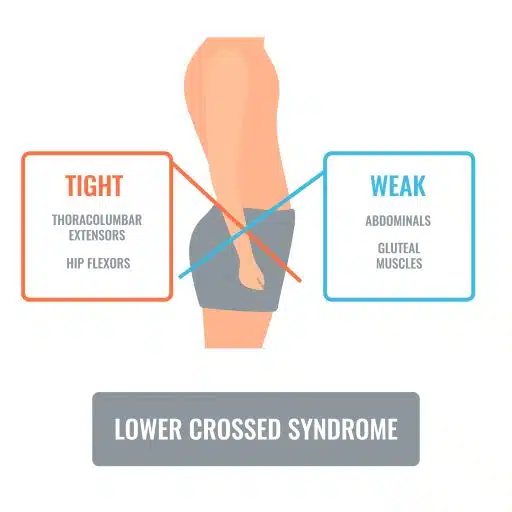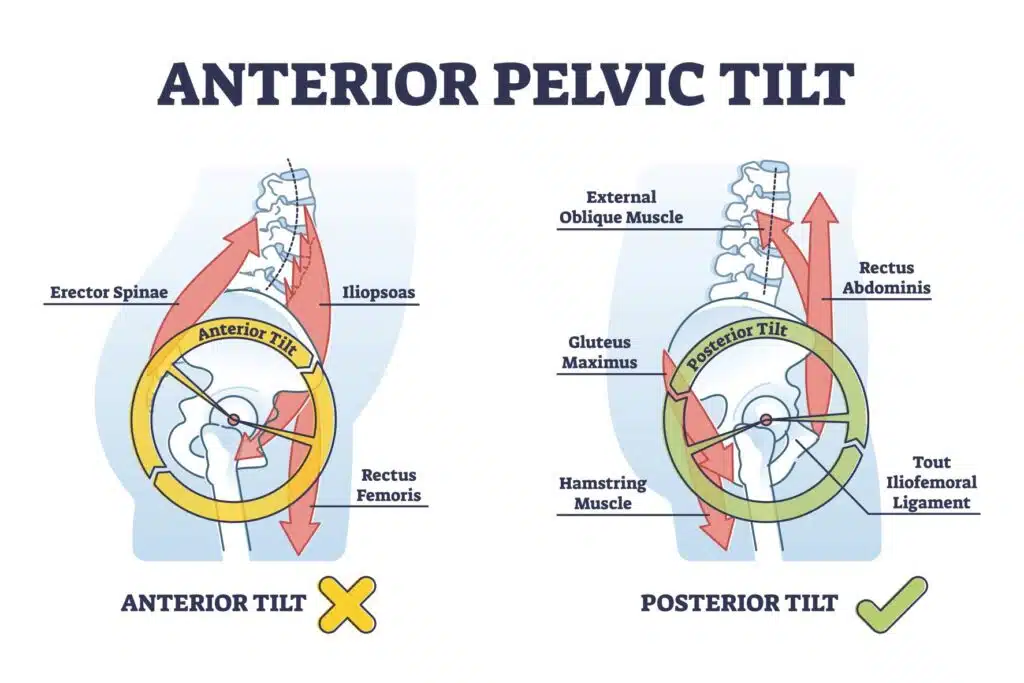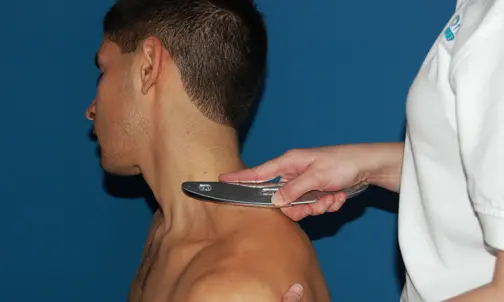What is Lower Crossed Syndrome?
Lower Crossed Syndrome (LCS) is a common posture-related issue that affects the lower back, hips, and core musculature. It occurs when there are imbalances in the muscles of the abdomen and other muscles attaching to the pelvis, resulting in an anterior pelvic tilt.
An anterior pelvic tilt is a common postural issue that occurs when the muscles in the lower back and abdomen become imbalanced. This imbalance causes the pelvis to tip forward, resulting in an exaggerated arch in the lower back. When viewed from the side, this outward curvature of the lower spine is known as a swayback.
Traditionally, a diagnosis is focused on identifying the source of a patient’s symptoms, such as specific tissues. This would be a structural diagnosis as it focuses on the tendinitis or strained muscle, for example. However, lower crossed syndrome is different in that it is considered a functional diagnosis. This means that we must look beyond the structure to identify any underlying factors to properly treat them.

Symptoms associated with Lower Crossed Syndrome
Symptoms associated with Lower Crossed Syndrome can include stiffness, low back pain and decreased mobility at the hip, shoulder, or other joints due to tightness in some muscles while other muscles remain weak or inhibited. In addition to pain and limited range of motion, it can also lead to difficulty stabilizing the spine during certain exercises or activities and changes in your gait pattern when walking or running. It is also associated with a multitude of other conditions throughout the legs.
Tight/Short Muscles in Lower Crossed Syndrome
- Hip Adductor Muscles (Inner Thigh and Groin)
- Erector Spinae m.
- Latissimus Dorsi m.
- Hip Adductor Muscles (Inner Thigh and Groin)
- Hip Flexor Muscles (Iliacus and Psoas Major m. = Iliopsoas m.)
- Calf Muscles (Gastrocnemius and Soleus m.)
WEAK/LENGTHENED MUSCLES IN LOWER CROSSED SYNDROME
- Gluteus Maximus m.
- Gluteus Medius m.
- Abdominal Core Muscles (Transverse Abdominus m. and Internal Oblique m.)
- Tibialis Posterior m.
- Tibialis Anterior m.

Common symptoms include low back pain, difficulty standing up straight for long periods, and decreased range of motion at joints such as hips or shoulders due to muscle tightness. It is associated with greater trochanteric pain syndrome, iliotibial band syndrome, patellofemoral pain syndrome, hamstring strains, and plantar fasciitis.

Causes of Lower Crossed Syndrome
The most common cause of Lower Crossed Syndrome is prolonged sitting with poor posture. Other causes include excessive physical activity or an increase in stress levels which can cause muscle tension and tightness.
Running can be a major contributor to Lower Crossed Syndrome. When running in improper or ill-fitting shoes, the increased pressure and shifting on the feet can cause tension in the muscles of the lower body. The hip flexors and lumbar erector spinae become tight, while the abdominals become weak or inhibited.
Long-Term Effects of Lower Crossed Syndrome
While poor posture can have serious long-term implications, muscular balance is key to keeping the body functioning properly. Without this balance in place, dysfunctional and incorrect movement patterns emerge – both regionally and globally. In turn, these change joint surfaces leading to a vicious cycle of recurring painful joints.
Furthermore, compromised posture has been linked with impaired proprioception as well as increased mortality rates among seniors. It’s clear that maintaining healthy postural habits should be nothing short of priority #1 for us all.
Treatments for Lower Crossed Syndrome
To address lower crossed syndrome, healthcare practitioners often start by reducing abnormal proprioceptive input through chiropractic adjustments, joint mobilization and myofascial release. This is followed by a sequential process of stretching, and strengthening exercises tailored to the individual’s goals and needs as well as re-educating normal movement patterns. Consequently, core stability training in addition to hip flexibility drills has been demonstrated to help improve function for those suffering from low back pain (LBP).
Muscles follow a rule called the law of reciprocal inhibition – which states that when one muscle group is hypertonic, its antagonist relaxes. It follows suit that tight muscles must be loosened and lengthened before proceeding with any form of strength work. Applying specific stretches or releasing tension via myofascial techniques would be ways of relaxing certain muscles.
Fortunately, Lower Crossed Syndrome can be treated with conservative methods such as stretching and strengthening exercises. These corrective exercises focus on both sides of your body equally to restore the balance between opposing muscle groups. Tight muscles should be loosened with myofascial release, Graston Technique, Cupping Therapy and massage therapy. To ensure a comprehensive approach to treatment, it is important for recovery that myofascial adhesions are released in their gluteal muscles. Trigger points can be actively treated using self-massage with tools such as foam rollers and manipulation of any lumbopelvic joint restrictions should not be overlooked either.
Tight muscles should also be stretched appropriately with stretching exercises focusing on the hip flexors, lumbar erector spinae, and abdominal muscles to improve flexibility.
Strengthening exercises should focus on the weak muscles like the posterior and anterior muscles of the trunk, back, and hips as well as the core muscles. Strengthening exercises focusing on the abdominal and gluteal muscles, along with proprioception activities like dead bugs, posterior lunges, clams, side bridging and BAPS board stability will help “groove new movement patterns.” A healthcare provider, like a chiropractic physician specializing in sports medicine, can help you develop an individualized exercise program tailored to your specific needs.
In addition to targeted strengthening and stretching exercises, Lower Crossed Syndrome can also be managed with lifestyle modifications. Ergonomic modifications such as a standing desk or better ergonomic chair can help reduce Lower Crossed Syndrome symptoms over time. Additionally, taking regular breaks from sitting and performing posture checks throughout the day can help to reduce Lower Crossed Syndrome symptoms and improve overall posture.



Prevention Strategies in Runners
To prevent Lower Crossed Syndrome from occurring, it is important to take preventive measures such as engaging in regular stretching and strengthening exercises that focus on both sides of your body equally to restore the balance between opposing muscle groups. Additionally, lifestyle changes such as ergonomic modifications at work or home and taking regular breaks from sitting can help reduce Lower Crossed Syndrome symptoms over time. For runners specifically, wearing properly fitting shoes with sufficient cushioning and support will help reduce tension on the feet which may contribute to Lower Crossed Syndrome symptoms. Finally, performing posture checks throughout the day will also help maintain good posture which can reduce Lower Crossed Syndrome symptoms.
Conclusion
Lower Crossed Syndrome can be a debilitating condition for runners, but with the right treatment and prevention strategies, it doesn’t have to be. By taking preventive measures like engaging in regular stretching and strengthening exercises that focus on harmony in your body as well as lifestyle modifications such as ergonomic changes at work or home and taking regular breaks from sitting, Lower Crossed Syndrome symptoms can be managed effectively. To ensure optimal results, however, those suffering from Lower Crossed Syndrome should seek an evaluation by a healthcare provider specializing in sports medicine so they can receive an individualized exercise program tailored to their specific needs. Don’t let Lower Crossed Syndrome slow you down; take action today!
